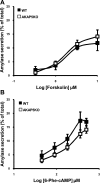The contribution of AKAP5 in amylase secretion from mouse parotid acini
- PMID: 20164376
- PMCID: PMC2867378
- DOI: 10.1152/ajpcell.00382.2009
The contribution of AKAP5 in amylase secretion from mouse parotid acini
Abstract
A-kinase (PKA) anchoring proteins (AKAPs) are essential for targeting type II PKA to specific locales in the cell to control function. In the present study, AKAP5 (formerly AKAP150) and AKAP6 were identified in mouse parotid acini by type II PKA regulatory subunit (RII) overlay assay and Western blot analysis of mouse parotid cellular fractions, and the role of AKAP5 in mouse parotid acinar cell secretion was determined. Mice were euthanized with CO(2). Immunofluorescence staining of acinar cells localized AKAP5 to the basolateral membrane, whereas AKAP6 was associated with the perinuclear region. In functional studies, amylase secretion from acinar cells of AKAP5 mutant [knockout (KO)] mice treated with the beta-adrenergic agonist, isoproterenol, was reduced overall by 30-40% compared with wild-type (WT) mice. In contrast, amylase secretion in response to the adenylyl cyclase (AC) activator, forskolin, and the cAMP-dependent protein kinase (PKA) activator, N(6)-phenyl-cAMP, was not statistically different in acini from WT and AKAP5 KO mice. Treatment of acini with isoproterenol mimicked the effect of the Epac activator, 8-(4-methoxyphenylthio)-2'-O-methyladenosine-3',5'-cyclic monophosphate (8-pMeOPT-2'-O-Me-cAMP), in stimulating Rap1. However, in contrast to isoproterenol, treatment of acini with 8-pMeOPT-2'-O-Me-cAMP resulted in stimulation of amylase secretion from both AKAP5 KO and WT acinar cells. As a scaffolding protein, AKAP5 was found to coimmunoprecipitate with AC6, but not AC8. Data suggest that isoproterenol-stimulated amylase secretion occurs via both an AKAP5/AC6/PKA complex and a PKA-independent, Epac pathway in mouse parotid acini.
Figures








Similar articles
-
The type 8 adenylyl cyclase is critical for Ca2+ stimulation of cAMP accumulation in mouse parotid acini.J Biol Chem. 2000 May 12;275(19):14691-9. doi: 10.1074/jbc.275.19.14691. J Biol Chem. 2000. PMID: 10799557
-
Adenylyl cyclase anchoring by a kinase anchor protein AKAP5 (AKAP79/150) is important for postsynaptic β-adrenergic signaling.J Biol Chem. 2013 Jun 14;288(24):17918-31. doi: 10.1074/jbc.M112.449462. Epub 2013 May 6. J Biol Chem. 2013. PMID: 23649627 Free PMC article.
-
Evidence for the involvement of cAMP-GEF (Epac) pathway in amylase release from the rat parotid gland.Arch Biochem Biophys. 2004 Nov 1;431(1):124-8. doi: 10.1016/j.abb.2004.07.021. Arch Biochem Biophys. 2004. PMID: 15464734
-
A-kinase anchoring proteins: cAMP compartmentalization in neurodegenerative and obstructive pulmonary diseases.Br J Pharmacol. 2014 Dec;171(24):5603-23. doi: 10.1111/bph.12882. Br J Pharmacol. 2014. PMID: 25132049 Free PMC article. Review.
-
Involvement of SAP97 anchored multiprotein complexes in regulating cardiorenal signaling and trafficking networks.Biochem Pharmacol. 2023 Feb;208:115406. doi: 10.1016/j.bcp.2022.115406. Epub 2022 Dec 31. Biochem Pharmacol. 2023. PMID: 36596415 Review.
Cited by
-
Ca²⁺-regulated secretory granule exocytosis in pancreatic and parotid acinar cells.Cell Calcium. 2014 Jun;55(6):369-75. doi: 10.1016/j.ceca.2014.03.003. Epub 2014 Mar 28. Cell Calcium. 2014. PMID: 24742357 Free PMC article. Review.
-
VIP and muscarinic synergistic mucin secretion by salivary mucous cells is mediated by enhanced PKC activity via VIP-induced release of an intracellular Ca2+ pool.Pflugers Arch. 2020 Mar;472(3):385-403. doi: 10.1007/s00424-020-02348-7. Epub 2020 Jan 13. Pflugers Arch. 2020. PMID: 31932898 Free PMC article.
-
Fusion of lysosomes with secretory organelles leads to uncontrolled exocytosis in the lysosomal storage disease mucolipidosis type IV.EMBO Rep. 2016 Feb;17(2):266-78. doi: 10.15252/embr.201541542. Epub 2015 Dec 18. EMBO Rep. 2016. PMID: 26682800 Free PMC article.
-
Intracellular cAMP Sensor EPAC: Physiology, Pathophysiology, and Therapeutics Development.Physiol Rev. 2018 Apr 1;98(2):919-1053. doi: 10.1152/physrev.00025.2017. Physiol Rev. 2018. PMID: 29537337 Free PMC article. Review.
-
AKAP6 and phospholamban colocalize and interact in HEK-293T cells and primary murine cardiomyocytes.Physiol Rep. 2019 Jul;7(14):e14144. doi: 10.14814/phy2.14144. Physiol Rep. 2019. PMID: 31325238 Free PMC article.
References
-
- Baggaley E, McLarnon S, Demeter I, Varga G, Bruce JI. Differential regulation of the apical plasma membrane Ca(2+)-ATPase by protein kinase A in parotid acinar cells. J Biol Chem 282: 37678–37693, 2007 - PubMed
-
- Bernfeld P. Enzymes of starch degradation and synthesis. Adv Enzymol Relat Subj Biochem 12: 379–428, 1951 - PubMed
-
- Bi Y, Williams JA. A role for Rho and Rac in secretagogue-induced amylase release by pancreatic acini. Am J Physiol Cell Physiol 289: C22–C32, 2005 - PubMed
Publication types
MeSH terms
Substances
Grants and funding
LinkOut - more resources
Full Text Sources
Molecular Biology Databases
Research Materials

